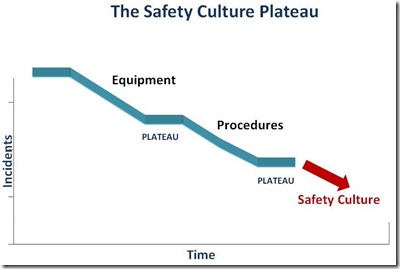The health and safety statistics for 2011/12 are a mixed bag, showing no overall trend. With some numbers up and some down, work-related injuries and fatalities seem to have hit a plateau. When this happened before, a change of approach enabled the downward trajectory to be recovered. It’s time for another rethink and this time the emphasis needs to be on safety culture – or human behaviour .
Tremendous strides have been made in health and safety since 1974, resulting in a huge reduction in injuries and fatalities. The first big reduction came from an emphasis on safer equipment – machine guards, access platforms, personal protective equipment and so on. Then there was a plateau, so an emphasis was placed on better procedures – including safe systems of work, risk assessments and permits to work. Breaking through the current plateau will be the most challenging of all as it will require an improved safety culture.
According to the UK Health and Safety Executive, most accidents (and other ‘business disruptions’) stem from employee errors or violations 1. This suggests that concentrating on equipment and procedures alone is not enough; safety culture needs to be added to the mix. Changing the safety culture is no mean feat; it involves changing the way individuals think about their job, their colleagues and their attitudes to risk. And it’s not a quick fix.
So where do you start? If employees need to think differently, then so do safety managers. To change the way operatives think about safety, higher levels of engagement are going to be needed; real engagement, which means winning over hearts and minds, rather than pinning another edict on the company notice board.
If hearts and minds are to be won over, measuring attitudes to safety and risk is a good place to start. These need to be forward-looking measures, as opposed to traditional “rear view mirror” metrics. And as Deming famously said, you can’t manage what you can’t measure.
1. HSE Human Factors Briefing Note No 7, Safety Culture – http://www.hse.gov.uk/humanfactors/topics/07culture.pdf
